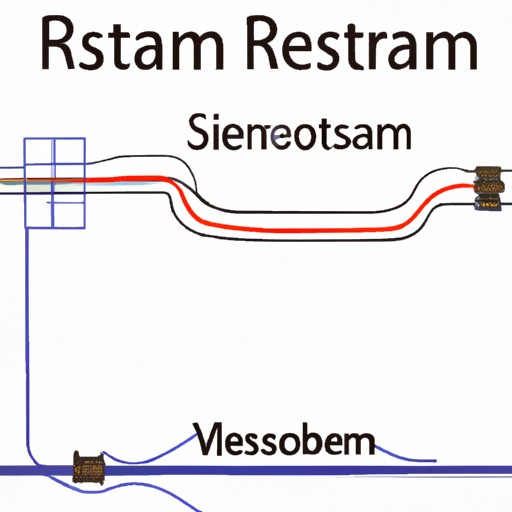Mainstream Resistor Wiring Diagram Product Series Parameters

I. Introduction
Resistors are fundamental components in electronic circuits, serving as the backbone for controlling current flow and voltage levels. They play a crucial role in ensuring that electronic devices function correctly and safely. Understanding how to wire resistors properly is essential for anyone involved in electronics, from hobbyists to professional engineers. This is where wiring diagrams come into play, providing a visual representation of how resistors and other components are interconnected. This article aims to educate readers on mainstream resistor wiring diagrams and the parameters associated with various product series, enhancing their understanding of this vital electronic component.
II. Understanding Resistors
A. What is a Resistor?
A resistor is a passive electrical component that limits or regulates the flow of electrical current in a circuit. By providing resistance, it helps to control voltage levels and protect sensitive components from excessive current. Resistors come in various types, including fixed resistors, which have a predetermined resistance value, and variable resistors, such as potentiometers, which allow users to adjust the resistance as needed.
B. Key Parameters of Resistors
When selecting a resistor for a specific application, several key parameters must be considered:
1. **Resistance Value (Ohms)**: This is the primary characteristic of a resistor, indicating how much it resists the flow of current. Resistance is measured in ohms (Ω), and the value can range from fractions of an ohm to millions of ohms.
2. **Power Rating (Watts)**: This parameter indicates the maximum amount of power a resistor can dissipate without being damaged. It is crucial to choose a resistor with an appropriate power rating to prevent overheating and failure.
3. **Tolerance**: Tolerance refers to the allowable deviation from the specified resistance value. It is usually expressed as a percentage. For example, a resistor with a 100Ω value and a tolerance of ±5% can have a resistance anywhere between 95Ω and 105Ω.
4. **Temperature Coefficient**: This parameter indicates how much the resistance value changes with temperature. It is essential for applications where temperature fluctuations are expected, as it can affect the performance of the circuit.
III. Wiring Diagrams: An Overview
A. Definition and Purpose of Wiring Diagrams
Wiring diagrams are visual representations of electrical circuits, illustrating how components are connected and how current flows through the system. They serve as essential tools for engineers and technicians, providing clarity and guidance during the design, assembly, and troubleshooting of electronic circuits.
B. Importance of Accurate Wiring Diagrams in Circuit Design
Accurate wiring diagrams are critical for ensuring that circuits function as intended. They help prevent errors during assembly, facilitate maintenance, and provide a reference for future modifications. A well-documented wiring diagram can save time and resources, making it an invaluable asset in any electronic project.
C. Common Symbols and Notations Used in Wiring Diagrams
Wiring diagrams use standardized symbols to represent various components, including resistors, capacitors, and power sources. Familiarity with these symbols is essential for interpreting diagrams correctly. For example, a resistor is typically represented by a zigzag line, while a power source may be depicted as a circle with a plus and minus sign.
IV. Mainstream Resistor Wiring Diagrams
A. Series and Parallel Configurations
Resistors can be connected in different configurations, primarily in series or parallel, each with distinct characteristics and applications.
1. Explanation of Series Wiring
In a series configuration, resistors are connected end-to-end, forming a single path for current to flow. The total resistance in a series circuit is the sum of the individual resistances. This configuration is commonly used in applications where a specific voltage drop is required across each resistor.
**Characteristics and Applications**: Series wiring is often used in voltage divider circuits, LED circuits, and applications where the same current flows through all components.
**Example Wiring Diagram**:
```
R1 ---- R2 ---- R3
```
2. Explanation of Parallel Wiring
In a parallel configuration, resistors are connected across the same two points, providing multiple paths for current to flow. The total resistance in a parallel circuit is less than the smallest individual resistance.
**Characteristics and Applications**: Parallel wiring is used in applications where it is essential to maintain the same voltage across all components, such as in power distribution systems.
**Example Wiring Diagram**:
```
R1
|
---|---
|
R2
|
---|---
|
R3
```
B. Mixed Configurations
Mixed configurations combine both series and parallel wiring, allowing for more complex circuit designs.
1. Explanation of Mixed Series-Parallel Wiring
In mixed configurations, some resistors are connected in series while others are connected in parallel. This approach enables designers to achieve specific resistance values and voltage drops tailored to the circuit's requirements.
2. Example Wiring Diagram
```
R1
|
---|--- R2
| |
R3 R4
| |
---|----|---
```
V. Product Series Parameters
A. Overview of Mainstream Resistor Product Series
Numerous manufacturers produce resistors, each offering various product lines tailored to different applications. Some well-known manufacturers include Vishay, Yageo, and Panasonic, each providing a range of resistors with varying specifications.
B. Detailed Examination of Product Parameters
1. **Resistance Range and Selection Criteria**: When selecting a resistor, it is essential to consider the required resistance value for the specific application. Manufacturers typically provide a catalog of available resistance values, allowing designers to choose the most suitable option.
2. **Power Ratings and Their Implications for Circuit Design**: The power rating of a resistor determines how much power it can handle without overheating. Designers must ensure that the selected resistor's power rating exceeds the expected power dissipation in the circuit to prevent failure.
3. **Tolerance Levels and Their Impact on Performance**: The tolerance level affects the precision of the resistor's performance. In applications requiring high accuracy, such as precision amplifiers, low-tolerance resistors are preferred.
4. **Temperature Coefficients and Their Relevance in Various Environments**: The temperature coefficient is crucial for applications exposed to varying temperatures. Resistors with low temperature coefficients are ideal for precision applications, while those with higher coefficients may be suitable for less critical uses.
VI. Practical Applications
A. Use of Resistor Wiring Diagrams in Real-World Applications
Resistor wiring diagrams are invaluable in various fields, including:
1. **Consumer Electronics**: Resistors are used in devices like televisions, radios, and smartphones to control current and voltage levels.
2. **Industrial Machinery**: In industrial settings, resistors help regulate power in motors and control systems, ensuring safe and efficient operation.
3. **Automotive Systems**: Resistors play a critical role in automotive electronics, including lighting systems, sensors, and control units.
B. Case Studies Highlighting Successful Implementations
Several case studies illustrate the successful application of resistor wiring diagrams in real-world scenarios. For instance, in a consumer electronics project, a designer used a series resistor configuration to create a voltage divider for an LED display, ensuring optimal brightness and performance.
VII. Conclusion
Understanding resistor wiring diagrams and product parameters is essential for anyone involved in electronics. These components are integral to circuit design, and their proper application can significantly impact performance and reliability. As technology continues to evolve, the role of resistors remains vital, making it crucial for enthusiasts and professionals alike to deepen their knowledge in this area. We encourage readers to explore further and engage with the electronics community to enhance their understanding and skills.
VIII. References
- "The Art of Electronics" by Paul Horowitz and Winfield Hill
- "Electronic Principles" by Albert Malvino and David Bates
- Online resources such as Digi-Key, Mouser Electronics, and the Electronics Stack Exchange for community engagement and support.
By understanding the intricacies of resistor wiring diagrams and product series parameters, readers can confidently approach their electronic projects, ensuring success and innovation in their designs.
Mainstream Resistor Wiring Diagram Product Series Parameters

I. Introduction
Resistors are fundamental components in electronic circuits, serving as the backbone for controlling current flow and voltage levels. They play a crucial role in ensuring that electronic devices function correctly and safely. Understanding how to wire resistors properly is essential for anyone involved in electronics, from hobbyists to professional engineers. This is where wiring diagrams come into play, providing a visual representation of how resistors and other components are interconnected. This article aims to educate readers on mainstream resistor wiring diagrams and the parameters associated with various product series, enhancing their understanding of this vital electronic component.
II. Understanding Resistors
A. What is a Resistor?
A resistor is a passive electrical component that limits or regulates the flow of electrical current in a circuit. By providing resistance, it helps to control voltage levels and protect sensitive components from excessive current. Resistors come in various types, including fixed resistors, which have a predetermined resistance value, and variable resistors, such as potentiometers, which allow users to adjust the resistance as needed.
B. Key Parameters of Resistors
When selecting a resistor for a specific application, several key parameters must be considered:
1. **Resistance Value (Ohms)**: This is the primary characteristic of a resistor, indicating how much it resists the flow of current. Resistance is measured in ohms (Ω), and the value can range from fractions of an ohm to millions of ohms.
2. **Power Rating (Watts)**: This parameter indicates the maximum amount of power a resistor can dissipate without being damaged. It is crucial to choose a resistor with an appropriate power rating to prevent overheating and failure.
3. **Tolerance**: Tolerance refers to the allowable deviation from the specified resistance value. It is usually expressed as a percentage. For example, a resistor with a 100Ω value and a tolerance of ±5% can have a resistance anywhere between 95Ω and 105Ω.
4. **Temperature Coefficient**: This parameter indicates how much the resistance value changes with temperature. It is essential for applications where temperature fluctuations are expected, as it can affect the performance of the circuit.
III. Wiring Diagrams: An Overview
A. Definition and Purpose of Wiring Diagrams
Wiring diagrams are visual representations of electrical circuits, illustrating how components are connected and how current flows through the system. They serve as essential tools for engineers and technicians, providing clarity and guidance during the design, assembly, and troubleshooting of electronic circuits.
B. Importance of Accurate Wiring Diagrams in Circuit Design
Accurate wiring diagrams are critical for ensuring that circuits function as intended. They help prevent errors during assembly, facilitate maintenance, and provide a reference for future modifications. A well-documented wiring diagram can save time and resources, making it an invaluable asset in any electronic project.
C. Common Symbols and Notations Used in Wiring Diagrams
Wiring diagrams use standardized symbols to represent various components, including resistors, capacitors, and power sources. Familiarity with these symbols is essential for interpreting diagrams correctly. For example, a resistor is typically represented by a zigzag line, while a power source may be depicted as a circle with a plus and minus sign.
IV. Mainstream Resistor Wiring Diagrams
A. Series and Parallel Configurations
Resistors can be connected in different configurations, primarily in series or parallel, each with distinct characteristics and applications.
1. Explanation of Series Wiring
In a series configuration, resistors are connected end-to-end, forming a single path for current to flow. The total resistance in a series circuit is the sum of the individual resistances. This configuration is commonly used in applications where a specific voltage drop is required across each resistor.
**Characteristics and Applications**: Series wiring is often used in voltage divider circuits, LED circuits, and applications where the same current flows through all components.
**Example Wiring Diagram**:
```
R1 ---- R2 ---- R3
```
2. Explanation of Parallel Wiring
In a parallel configuration, resistors are connected across the same two points, providing multiple paths for current to flow. The total resistance in a parallel circuit is less than the smallest individual resistance.
**Characteristics and Applications**: Parallel wiring is used in applications where it is essential to maintain the same voltage across all components, such as in power distribution systems.
**Example Wiring Diagram**:
```
R1
|
---|---
|
R2
|
---|---
|
R3
```
B. Mixed Configurations
Mixed configurations combine both series and parallel wiring, allowing for more complex circuit designs.
1. Explanation of Mixed Series-Parallel Wiring
In mixed configurations, some resistors are connected in series while others are connected in parallel. This approach enables designers to achieve specific resistance values and voltage drops tailored to the circuit's requirements.
2. Example Wiring Diagram
```
R1
|
---|--- R2
| |
R3 R4
| |
---|----|---
```
V. Product Series Parameters
A. Overview of Mainstream Resistor Product Series
Numerous manufacturers produce resistors, each offering various product lines tailored to different applications. Some well-known manufacturers include Vishay, Yageo, and Panasonic, each providing a range of resistors with varying specifications.
B. Detailed Examination of Product Parameters
1. **Resistance Range and Selection Criteria**: When selecting a resistor, it is essential to consider the required resistance value for the specific application. Manufacturers typically provide a catalog of available resistance values, allowing designers to choose the most suitable option.
2. **Power Ratings and Their Implications for Circuit Design**: The power rating of a resistor determines how much power it can handle without overheating. Designers must ensure that the selected resistor's power rating exceeds the expected power dissipation in the circuit to prevent failure.
3. **Tolerance Levels and Their Impact on Performance**: The tolerance level affects the precision of the resistor's performance. In applications requiring high accuracy, such as precision amplifiers, low-tolerance resistors are preferred.
4. **Temperature Coefficients and Their Relevance in Various Environments**: The temperature coefficient is crucial for applications exposed to varying temperatures. Resistors with low temperature coefficients are ideal for precision applications, while those with higher coefficients may be suitable for less critical uses.
VI. Practical Applications
A. Use of Resistor Wiring Diagrams in Real-World Applications
Resistor wiring diagrams are invaluable in various fields, including:
1. **Consumer Electronics**: Resistors are used in devices like televisions, radios, and smartphones to control current and voltage levels.
2. **Industrial Machinery**: In industrial settings, resistors help regulate power in motors and control systems, ensuring safe and efficient operation.
3. **Automotive Systems**: Resistors play a critical role in automotive electronics, including lighting systems, sensors, and control units.
B. Case Studies Highlighting Successful Implementations
Several case studies illustrate the successful application of resistor wiring diagrams in real-world scenarios. For instance, in a consumer electronics project, a designer used a series resistor configuration to create a voltage divider for an LED display, ensuring optimal brightness and performance.
VII. Conclusion
Understanding resistor wiring diagrams and product parameters is essential for anyone involved in electronics. These components are integral to circuit design, and their proper application can significantly impact performance and reliability. As technology continues to evolve, the role of resistors remains vital, making it crucial for enthusiasts and professionals alike to deepen their knowledge in this area. We encourage readers to explore further and engage with the electronics community to enhance their understanding and skills.
VIII. References
- "The Art of Electronics" by Paul Horowitz and Winfield Hill
- "Electronic Principles" by Albert Malvino and David Bates
- Online resources such as Digi-Key, Mouser Electronics, and the Electronics Stack Exchange for community engagement and support.
By understanding the intricacies of resistor wiring diagrams and product series parameters, readers can confidently approach their electronic projects, ensuring success and innovation in their designs.













